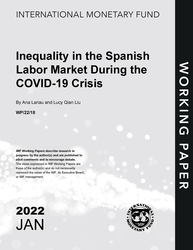
Inequality in the Spanish Labor Market During the COVID-19 Crisis
Inequality in the Spanish Labor Market During the COVID-19 Crisis
READ MORE...
Volume/Issue:
Volume 2022
Issue 018
Publication date: January 2022
ISBN: 9798400201059
$5.00
Add to Cart by clicking price of the language and format you'd like to purchase
Available Languages and Formats
| English |
Prices in red indicate formats that are not yet available but are forthcoming.
Topics covered in this book
This title contains information about the following subjects.
Click on a subject if you would like to see other titles with the same subjects.
Labor , Economics- Macroeconomics , Economics / General , COVID-19 pandemic , Labor market , Inequality , Job retention schemes , Spain , labor market differential effect , differential impact , temporary contract , labor market outcome , differential effect , Labor markets , COVID-19 , Income inequality , Unemployment , Income distribution , Europe
Also of interest
Summary
We analyze the differential impact of the COVID-19 crisis on the Spanish labor market across population groups, as well as its implications for income inequality. The main finding is that young, less educated, and low skilled workers, as well as women are the most affected by the COVID-19 shock in terms of job loss rates. The differential impacts were especially acute at the height of the pandemic in 2020 and remain robust after taking into account the heterogeneity of sector characteristics. Given that these vulnerable groups were positioned in the lower end of the income distribution before the crisis, we hypothesize that income inequality likely has increased due to the pandemic. Policies aiming at reducing inequality in the labor market need to go beyond measures that target the hardest-hit sectors and support the vulnerable groups more directly.
Copyright © 2010 - 2026
Powered by:
AIDC



